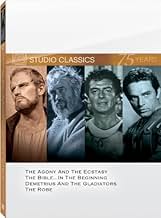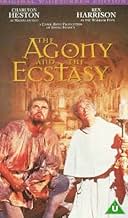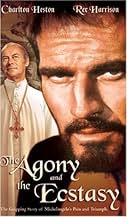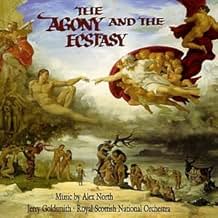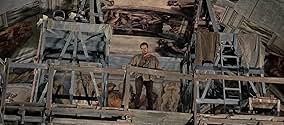Michelangelo - Inferno und Ekstase
Originaltitel: The Agony and the Ecstasy
IMDb-BEWERTUNG
7,2/10
8420
IHRE BEWERTUNG
Die biografische Geschichte von Michelangelos Schwierigkeiten bei der Ausmalung der Sixtinischen Kapelle auf Drängen von Papst Julius II.Die biografische Geschichte von Michelangelos Schwierigkeiten bei der Ausmalung der Sixtinischen Kapelle auf Drängen von Papst Julius II.Die biografische Geschichte von Michelangelos Schwierigkeiten bei der Ausmalung der Sixtinischen Kapelle auf Drängen von Papst Julius II.
- Regie
- Drehbuch
- Hauptbesetzung
- Für 5 Oscars nominiert
- 3 Gewinne & 9 Nominierungen insgesamt
Fortunato Arena
- Pope's Bodyguard
- (Nicht genannt)
Lars Bloch
- Baron Von Silenen
- (Nicht genannt)
Angelo Boscariol
- Papal Guard
- (Nicht genannt)
Calisto Calisti
- Physician
- (Nicht genannt)
Amerigo Castrighella
- Quarry cart assistant
- (Nicht genannt)
Anita Ceccotti
- Woman Under the Chapel
- (Nicht genannt)
Enrico Chiappafreddo
- Tavern Customer
- (Nicht genannt)
Ausgewählte Rezension
The film is an epic grandeur feature of a interpersonal tug-of-war between the maestro Michelangelo and Pope Julius II.
I cannot help being shell-shocked to see the reconstruction of the magnificent ceiling though recognizably most of which is the trickery of montage (not in the real the Sistine Chapel, the location was inside Cinecitta Italy instead), but bathing under the glamour and solemnness of the visual wonders, I am stunned to exude my admiration and awe!
The two leads conspicuously stimulate a Moses versus Caesar confrontation, Charlton Heston seems to be more boorish than artistic to manifest a struggled Michelangelo, may God doesn't distinguish his people by their looks. The "agony and ecstasy" is watered down to an underwhelming stalemate thanks to Charlton's outlandish incarnation as the most eminent artist of that time. Rex Harrison, is by far and large worthy another Oscar nomination for his arresting devotedness, which is apt to impress the audience with a mind-blowing bi-polar characterization while good and evil coexist at the same time.
The film was a grave box office fiasco when it came out in 1965, however, judging by my appraisement, its merits still can be appreciated by our generation (a well-balanced script, the haunting original score and all the props and settings). However, the film entirely skipped Michelangelo's sexual orientation and awkwardly ploys a portentous conversation between Michelangelo and his admirer Contessina de'Medici (a over-wise Diane Cilento), which unveiled its cowardliness and helplessness.
My final remark is that as time goes by ruthlessly, art stands still and never fades away, so lucky enough cinema is yet a part of it.
I cannot help being shell-shocked to see the reconstruction of the magnificent ceiling though recognizably most of which is the trickery of montage (not in the real the Sistine Chapel, the location was inside Cinecitta Italy instead), but bathing under the glamour and solemnness of the visual wonders, I am stunned to exude my admiration and awe!
The two leads conspicuously stimulate a Moses versus Caesar confrontation, Charlton Heston seems to be more boorish than artistic to manifest a struggled Michelangelo, may God doesn't distinguish his people by their looks. The "agony and ecstasy" is watered down to an underwhelming stalemate thanks to Charlton's outlandish incarnation as the most eminent artist of that time. Rex Harrison, is by far and large worthy another Oscar nomination for his arresting devotedness, which is apt to impress the audience with a mind-blowing bi-polar characterization while good and evil coexist at the same time.
The film was a grave box office fiasco when it came out in 1965, however, judging by my appraisement, its merits still can be appreciated by our generation (a well-balanced script, the haunting original score and all the props and settings). However, the film entirely skipped Michelangelo's sexual orientation and awkwardly ploys a portentous conversation between Michelangelo and his admirer Contessina de'Medici (a over-wise Diane Cilento), which unveiled its cowardliness and helplessness.
My final remark is that as time goes by ruthlessly, art stands still and never fades away, so lucky enough cinema is yet a part of it.
- lasttimeisaw
- 9. Aug. 2011
- Permalink
Handlung
WUSSTEST DU SCHON:
- WissenswertesThe book on which this movie is based covers the entire life of Michelangelo Buonarroti. This movie based on a single chapter. One of the shortest, if not the shortest, in the entire book.
- PatzerAs shown in the movie, Michelangelo created a flat wooden platform on brackets built out from holes in the wall, high up near the top of the windows. But contrary to what is depicted in the film, he did not lie on this scaffolding while he painted, but painted from a standing position.
- VerbindungenEdited from Prologue: The Artist Who Did Not Want to Paint (1965)
Top-Auswahl
Melde dich zum Bewerten an und greife auf die Watchlist für personalisierte Empfehlungen zu.
- How long is The Agony and the Ecstasy?Powered by Alexa
Details
- Erscheinungsdatum
- Herkunftsland
- Sprachen
- Auch bekannt als
- The Agony and the Ecstasy
- Drehorte
- Piazza del Popolo, Todi, Perugia, Umbria, Italien(St. Peter's Square scene)
- Produktionsfirma
- Weitere beteiligte Unternehmen bei IMDbPro anzeigen
Box Office
- Budget
- 10.000.000 $ (geschätzt)
- Laufzeit2 Stunden 18 Minuten
- Farbe
- Seitenverhältnis
- 2.20 : 1
Zu dieser Seite beitragen
Bearbeitung vorschlagen oder fehlenden Inhalt hinzufügen

Oberste Lücke
What is the Japanese language plot outline for Michelangelo - Inferno und Ekstase (1965)?
Antwort













